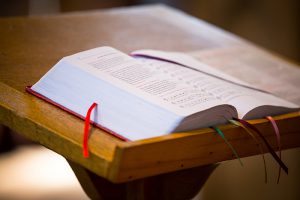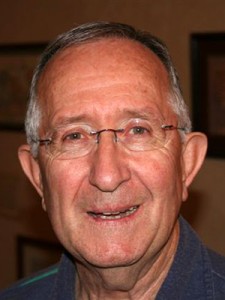By Johnnie Godwin
 Contributing Columnist, Baptist and Reflector
Contributing Columnist, Baptist and Reflector
“Confabulation” might be defined as remembering what never happened or didn’t happen the way you remember it. Besides my own memories, my B&R columns have the help of journals my mother started writing when she was 16. And she gave me a journal when I was about to turn 16. And I still write one full page each day to summarize what I remember. Someone wrote, “The dimmest ink is stronger than the strongest memory. Given these caveats, let me share some of my memories about when churches are alive on both sides of the pulpit — when there was participation to a much stronger degree than now.
Singing congregations tend to reflect living churches. When I was a boy, B. B. McKinney led music in a revival or two in my home church (First Baptist of Midland, Texas). Dad loved singing, whistling and hearing good music. And after B. B. McKinney had led a few revival services, I remember Dad commenting, “That ole man can’t sing very well; but he can get more singing out of a crowd than anyone I ever saw.” Dad told things just like he saw them or felt them.
Our church was a singing church! We had a minister of music, a grand piano and an upright. And we had a robed choir. Though our church was large, we didn’t have an orchestra or screens or high-powered amplification systems. But we didn’t need all these things that were to evolve into what we have today. It seemed that everyone in the church sang. And when we youth gathered, we sang choruses.
When I became a pastor, my first part of the job was leading congregational singing. Though I’m not a musician, I did take a couple of courses in what I call “arm-waving” leadership. Dr. Euell Porter was head of the religious music department at Baylor; and I had him teach me how to lead congregational singing. The small mission church I became pastor of didn’t have a minister of music; and the upright piano obviously was always in need of tuning. But, my, how we sang! Then I preached with all the life within me!
Country churches that were alive. I grew up as a city boy in a singing church in town. But when I started pastoring, I pastored several country churches. The last one of those had a grand piano and a Baldwin upright. There were about half a dozen accomplished pianists; and the lay song-leader expected everyone to participate. And when the singing was over, I was primed to preach and didn’t let most folks sleep.
Lesson from a seminary professor. Later, my missions professor at Southwestern Baptist Theological Seminary was Cal Guy. Before we got into missiology, he led us in militant Christian songs; and he led with his fist. We had a piano too. If we started off singing, say, “Onward Christian Soldiers” in a wimpy way, he would stop us. Then he would lecture us about singing and preaching like Christian soldiers for our Lord. And we would begin again — with power!
But churches may seem to be dead on one or both sides of the pulpit. “Symbiosis” is a word that means “life together.” Or it could mean living and leading together. Some churches have dead congregations. The preacher might as well be preaching to a fence post or a stone wall as to his congregation from all he can tell. I’ve pastored churches much of my life, and I can testify what I said is true.
I remember when even a visitor or a stranger could have come into one of our worship services and not have a doubt that our church was alive on both sides of the pulpit. But many Baptist churches kind of died on the vine — on one side of the pulpit or both sides. What a shame!
One Easter morning I preached a 25-minute sermon in my church in East Texas. That afternoon I and some of our folks went to an African American church, and I preached that same sermon. It lasted 45 minutes! Why? Same preacher; same sermon; but a different congregation. Those people sang so that even as square as I am I patted my foot and beat time to the music. When I preached, the folks said amen; that’s right; preach on! And when I finished, they “lifted” the offering. The people participated. They were alive on both sides of the pulpit.
Remembering worship from dim ink. I inherited my mother’s diaries. She and Dad had many of their dates recorded as going to singing schools on a Sunday afternoon or a singing at night. I pastored churches that told me they didn’t want any preaching; they just wanted me there for the all-day singing; and they wanted me to lead at least one of the songs. They insisted on paying me, and I had learned how to wave my arm. Cultures have changed, and they tend to change more slowly than even the climate. But they have changed. And on the participation side, many or most of them seem to have changed for the worse.
When I read Mother’s old diaries, I read about lively churches and lively preaching. And when I reach my own pastoral diaries, I can tell when we had lively singing and services; and I do remember a lot of that.
Today, I belong to a lively church with a lively pastor. The choir and minister of music are excellent. But honestly, we’ve become more of a performance-based church on the singing than a participating church. I’m suggesting that whatever our churches do today, that they find a way to go back to the old-time way. Learn to sing! Participate! Give the pastor an amen; a shout; a “That’s right!” “Preach on!” Let’s find a way to let God help our worship get born again if it has become dead or sleepy. In conclusion, I say, double amen! B&R

